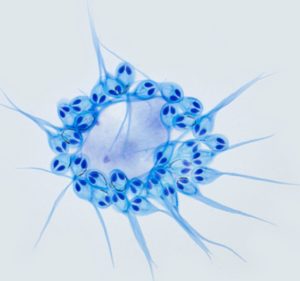
The TWiM team explains how breathing can transmit SARS-CoV-2, and how lack of breathing leads to loss of mitochondria in a multicellular parasitic animal.
Hosts: Vincent Racaniello, Elio Schaechter, Michele Swanson and Michael Schmidt
Right click to download TWiM#218 (45 MB .mp3, 62 minutes)
Subscribe to TWiM (free) on iTunes, Google Podcasts, Stitcher, Android, RSS, or by email. You can also listen on your mobile device with the Microbeworld app.
Become a Patron of TWiM!
Links for this episode
- Reducing transmission of SARS-CoV-2 (Science)
- Why social distancing is important (NY Times)
- Parasite without mitochondria (PNAS)
- Letters read on TWiM 218
Music used on TWiM is composed and performed by Ronald Jenkees and used with permission.
Send your microbiology questions and comments to twim@microbe.tv

Elio…stay healthy and engaged..you are the best of our species along with all microbe.tv podcast participants..the stream of consciousness is breathtaking…
1 grateful Canadian..
Bruce Fehr
Dear TWiMmers: Vincent, notice that no one calls you “cranky” here!
I have to write to tell you how much I enjoyed this episode. I guess that my self isolation is getting to me; I kept responding verbally as you four were discussing the cnidarian paper! Part of me was surprised that none of the four of you responded to my comments while I was on the treadmill! I have to get back to the lab.
I teach a class involving “symbiosis and parasitism” and I always try to bring up the truly unusual things in our world relating to this topic. And, in fact, last semester I did indeed talk about these very unusual animals called the myxozoa! I did not have the uber recent PNAS paper behind the paywall, but I did provide my students with plenty of interesting material. I hope you have all seen this from the Scientific American blog back in 2015:
https://blogs.scientificamerican.com/artful-amoeba/when-jellyfish-became-parasites-strange-things-happened/
That’s correct—these odd organisms are pretty much a pared down and “Darwinnowed” giant nematocyst from a jellyfish! And the myxozoa have made so many odd and wonderful adaptations (including life within the eggs of sturgeon) and display so many morphological oddities.
The essay is really quite wonderful.
The end of this accessible essay by the essential Jennifer Frazer puts it best:
“That we live on a planet where jellyfish can turn themselves inside out in the eggs of giant paddlefish, transform from pulsating bells into wriggling worms, or bid farewell to the ocean entirely and find themselves adrift on land in the bodies of cane toads or common shrews makes me happy beyond belief (although I’m sure I would not think so were I a shrew). Vive la difference.”
In sadder news, I read that the great Dale Kaiser of Stanford has passed away. A million years ago, I thought about trying to convince him to let me study Myxococcus xanthus as a postdoc, but I didn’t want to push him…he was such a wonderful person, and a remarkable scientist. Much missed.
https://devbio.stanford.edu/
As always, I appreciate what you all do for promoting microbiology to the public…and even other scientists like myself!
Your pal, Mark Martin